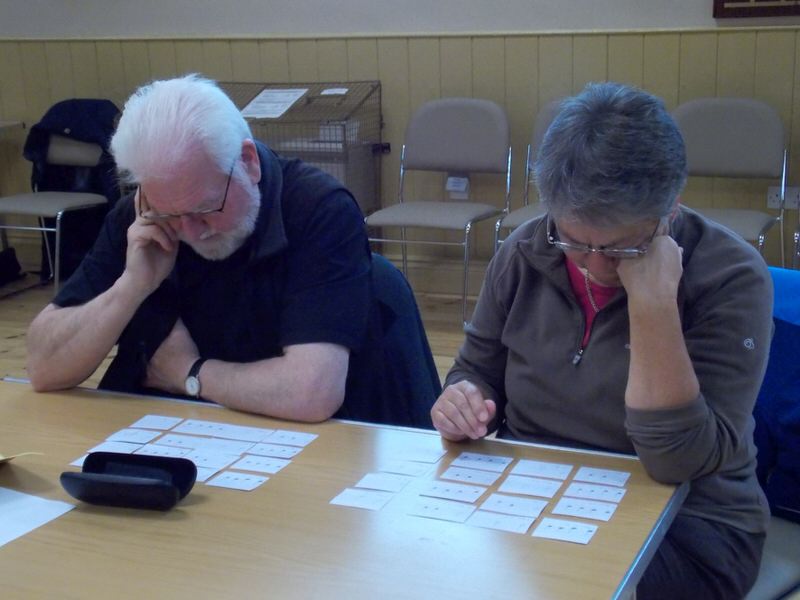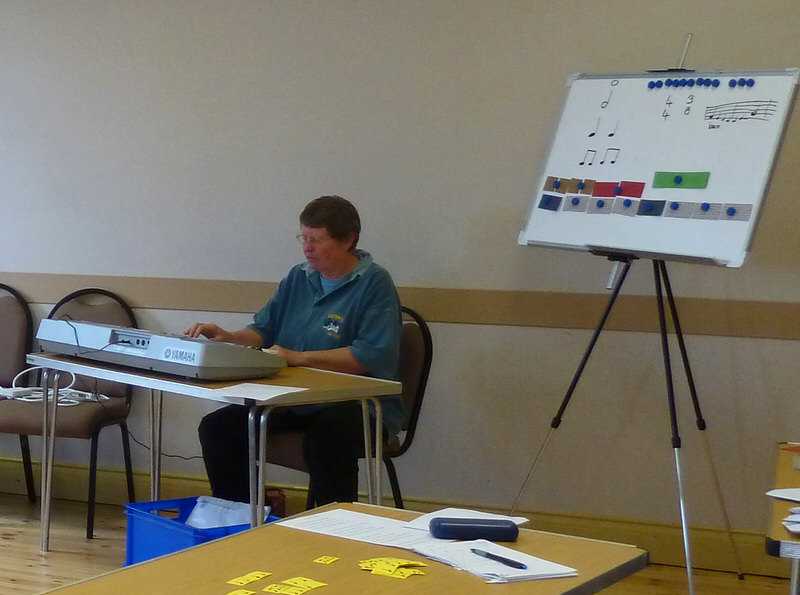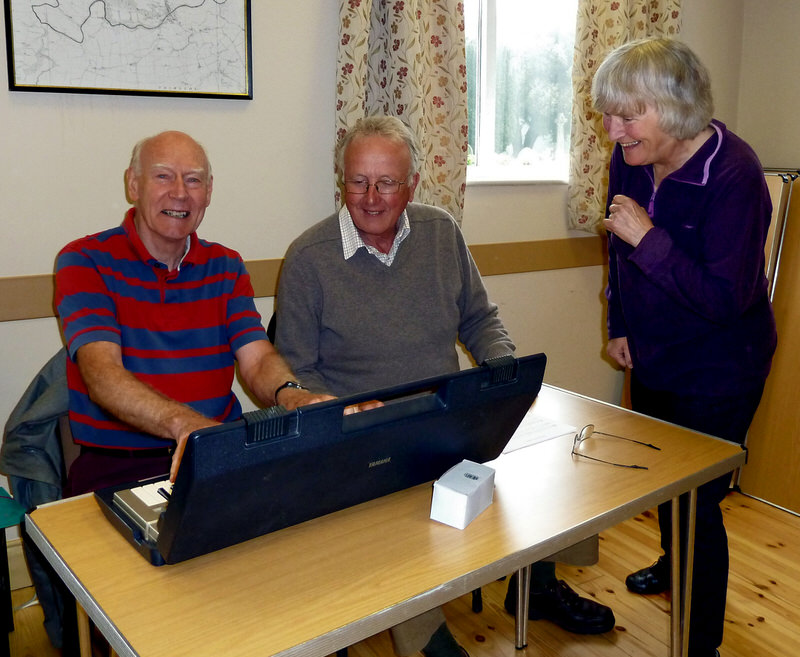Music Literacy Course
Many adults involved in music making wish they could read music better – or at all. This course is designed to help people acquire not only the knowledge, but the skills needed to make better use of music notation. It is a practical course, involving listening, singing, playing and exploring in order to read effectively.
Over several years, the course has proved popular and useful. It has been revised to allow people more time to reinforce their skills and understanding.
The course is offered in 5 modules, each of three sessions, 2 or 3 weeks apart, with things to do and practise at home. Each session is 2 ½ hours. The modules are:
1. Building Foundations with 5 notes
2. Building Foundations: how tunes work
3a.Rhythm Workshop
3b. Scales and Keys
3c. Chords and Harmony
Module 1 starts at the very beginning, ensuring that those who have no experience aren't left behind, while those with some can fill in any gaps in their understanding. Modules 3a, 3b and 3c are suitable for people who have worked through the first two modules or already have some competence reading music practically.
Module 1 ran in two locations in the spring of 2019. Module 2 will be offered in the autumn, closely followed by whichever of the remaining modules people would like. Module 1 will happen again as soon as there is a viable group – a minimum of 6.
Access to a keyboard is essential for all the modules except 3a – and it's helpful for that one. It is a reference point and support for anything to do with pitch and allows you to develop a relationship between pitch and finger movements. It's best if the keyboard has full size keys, but it doesn't have to be a large or complicated machine. People who don't have a keyboard already have been able to borrow from a friend or purchase at a reasonable price.
The course works best with a fairly small group – 6 to 8 is ideal. If a module runs at Felton Village Hall the cost works out at about £15 each, ie £5 a session, to cover room hire, materials and refreshments. The course can meet in someone's house, reducing the cost, but there must be room for keyboards.
If you are interested in attending a module or want to discuss whether one could be right for you email Alison at felton4music@gmail.com so you can be consulted about dates and times.
Music Literacy Course Content
Every module will:
use a repertoire of well known tunes as examples and reference
develop participants' ability to think music visually, kinaesthetically and aurally
improve knowledge, understanding and skills
enable participants to become more musically independent and confident
Module 1: Building Foundations with 5 notes
Relate the first 5 notes of the major scale to the fingers, play them on a keyboard and sing them in any order.
Maintain a steady beat and relate it to basic rhythm notation.
Recall, analyse, compare, manipulate and envisage music patterns in the mind's eye.
Accumulate a remembered vocabulary of common musical patterns.
Read and write staff notation using 5 notes and basic rhythms
Module 2: Building Foundations: how tunes work
Extend the 5 note repertoire to the 8 notes of the major scale.
Understand the 4 basic metres of music, their time signatures and how they are notated.
Learn and use basic rests.
Understand the basics of tonality – that all notes in a scale are not equal, the power of tonic and dominant, and how to use this knowledge to help reading.
Explore the structure of short tunes and recognise by ear and eye common patterns such as repetition, inversion, and sequence.
Module 3a: Rhythm Workout
How we ended up with the rhythm notation we have.
Master simple and compound time.
Recognise most note and rest symbols and work out the others.
Work with dots, ties.
Understand syncopation, recognise it, relate it to a steady beat, work out how to perform it.
Work out unusual and changing time signatures, and read music using them
Module 3b: Scales and Keys
Understand semitones, aurally, played, sung and written.
Overview the range of scales in common use: modes, major, minor, pentatonic, chromatic, whole tone.
Construct, analyse and recognise scales.
Understand the concept of a key signature.
Understand how major and minor scales relate, and the pattern of key signatures.
Recognise at sight common keys and work out all.
Understand and recognise visually modulation.
Module 3c: Chords and Harmony
Understand consonance and dissonance.
Understand the structure of major and minor triads, how they can be inverted, and recognise triadic patterns in melodies.
Pitch each of the notes of a triad.
Understand, play, sing and recognise sequences of tonic, subdominant and dominant chords in different genres.
Work out chords in SATB music.
Understand suspensions.
Understand principle of 7th, 9th, 11th, 13th,, 6th, aug, dim, sus chords and how
guitar chord symbols work.
What Music Literacy Is
Music Literacy: “I wish I could read music”
One of the most commonly expressed wishes amongst adults who like music is “I wish I could read music”. Reading isn't needed for lots of types of music, but it's really useful for “classical” music.
This article is designed to explain what music literacy is and what's involved in starting to acquire it. Many of the people who would like to read music better sing in choirs. Sometimes adults are deterred from taking up an instrument because they can't read music and think it will be too much of a barrier. Whether you sing or play, or would like to, find out the approach to music literacy offered by Felton Music. It can help you become more competent and confident.
Unpicking the Skill
If you sing in a choir you may be familiar with this scenario. You're sitting there in the rehearsal. A new piece of music is handed out. “Let's get a feel of how it goes” says the director. The starting notes are given, you're counted in and the singing starts. Around you several people are singing this stuff they've never seen before. Depending on your skill level relative to the difficulty of the music, you are either hanging on to their lead or pretty well lost. You know that once the director starts the note bashing process, you'll be able to take part properly and start memorising your line.
How on earth are those music readers doing it? Even when they make a mistake, they seem to be able to get themselves in again.
Listen more carefully and you'll notice there's quite a range of competence. Being able to read music is not a can or can't thing.
Ask those who can read how they do it, and often they find it difficult to explain. Can you explain how you learned to read words?
In order to read the music at sight the person is drawing on:
knowledge of the sounds the patterns of symbols represent
knowledge of the words and symbols that give information about how the notes are to be performed
an internalised clock to calculate the relative length of the notes (and silences)
an internalised scale of notes to get the jumps between the notes the right size
access to a store of remembered common patterns to allow the reader to make assumptions and predictions about the music (like a vocabulary)
the ability to get information from all the simultaneous lines of music
the ability to relate the sound they are making to the sounds around them
And all this has to happen in real time – it has to be a fluent process.
You'll notice that there's nothing here about the names of the notes – all that A, B, C business, or crotchets and quavers. That's useful information that helps people talk and learn about music, but it doesn't get you into reading it any more than knowing the alphabet gets you into reading words.
Sometimes those who don't read music believe that those who can are blessed with perfect pitch. That's a really rare competence. It's when you can say to the person “sing a D” and they can do it straight away without having heard any other notes. It's like having a piano in your head. Apart from being almost impossible to learn once you're past the age of about seven, it's not always such a good thing – imagine trying to sing with a choir that's gone flat.
The pitching skill that we'd all like to improve is relative pitch. That's when someone says to you “here's the note G, now sing a D”. That's really useful. Some people are brilliant at it, pitching any note from any other, even under pressure. I can't manage that well. I can do some jumps straight away. For others I have to have a strategy to work them out, or borrow them from another part. It's rather like mental arithmetic, some answers are instant while others have to be calculated. All music readers are at different points along the competence continuum, and can improve.
Audiation
In 1975 Edwin Gordon, an American educationalist, coined the term “audiation” for the process going on in the brain when one is thinking in music. He equated it to thought in language. Thinking in language means we can recall, reflect and plan using unspoken words. We can also manipulate word patterns and think about language. Written text evokes thoughts in our minds. To become musically literate, at however basic a level, you need to develop your ability to audiate.
You may think that you can't audiate. You probably can and it's just a matter of becoming conscious of it. Even if it feels as though it's a new mental process for you, fear not. It's easy and fun to get started, very empowering, and you can practise it wherever you are.
Staff Notation and how it works
When people talk about reading music they usually mean the way of writing down music called staff notation. The staff or stave is the set of five horizontal lines on which symbols are written. There are other ways of writing music down. Guitarists and other players of instruments with frets use tablature (tab). This is a system of pictures which show you where to put your fingers. Some software produces graphic notation. Tonic sol-fa (doh, ray, me etc.) doesn't need the stave. Letters represent the sounds in the scale. Staff notation is universal and works for any instrument: it's handy to understand it. It's what's used in most choirs, orchestras and bands.
Staff notation deals mainly with two aspects of music, pitch (the up and down of the notes) and rhythm (how the notes move through time).
Pitch is notated graphically showing the up and down. The five lines of the stave help the eye see how the notes relate to each other. The concept is simple. What takes learning is internalising a repertoire of pitch patterns so the jumps between the notes are accurate. That's where audiation really comes in.
Rhythm is notated symbolically. Each of the notes – crotchets, minims and so on tells the reader how long they should sound relative to the beat. Nowadays, printers of music try to help the reader by distributing the notes proportionately, but often this isn't possible. In order to read music in real time you need to accumulate a repertoire of common rhythms. There isn't time to work everything out mathematically. Very importantly, you have to be able to maintain a steady beat.
The traditional way of learning to read music
Most of the adults around who read fluently learned an instrument. The skills of playing and decoding are taught in tandem. There's the option of taking examinations. These test aural development (recalling and identifying notes and patterns), and reading music at sight as well as technical skills and performance. The best teachers integrate the separate strands of aural, reading and theory with practical skills. A minority learn to read music through singing, meaning they jump straight in to relating image to sound, with no decoding.
Those who don't play the piano, but show potential in music may be encouraged to learn. The piano presents the opportunity to combine notes, and helps makes sense of a lot of aspects of music theory. It's a really useful reference point.
In this tradition, music theory means understanding written music and all its conventions – clefs, key and time signatures, sharps and flats, notes and rests.
Learning to read music as an adult
If you have the time you could replicate the traditional approach. Even if you want to learn an instrument, through, you can speed the process by getting into music literacy head on, rather than tackling it at the same time as you are mastering finding the notes.
In recent years, neurological research has demonstrated that we really can learn new skills as adults, even at ages when previous generations would have taken to the pipe and slippers. It can take a bit longer to build the connections in the brain, but we can use the self knowledge accumulated through life to manage our learning efficiently.
“Practice is all. If you practice, you improve.”
In order to develop music literacy as effectively as possible it's helpful if you:
Have realistic expectations
None of us would expect to start learning a new skill as an adult and be as good as a professional after a few months. Music literacy is a big skill, but you can exercise at all levels, and the more exercise it gets, the more it improves.Don't mind working with the simplest of music materials.
If you start Russian lessons you don't expect to start with Dostoevsky. People who sing in choirs are often performing very sophisticated music – too complex to help you learn the fundamentals of music literacy.Are prepared to have a go
You can't learn any of this without making sounds, on the keyboard and vocally. Taking a relaxed approach, exploring and not minding making audible errors helps learning. Remember we talk about “playing” music. Be playful.Can cope with being a beginner.
We vary in how comfortable we feel being unskilled.Set aside your ability to learn by ear
Your musical memory is probably well developed, but you need to consciously put it aside to learn the new skill of reading. You'll probably continue to use memory at choir rehearsals all of the time initially.
Consciously manage your thinking processes and learning
To learn this skill you have to build new connections in the brain. This is what takes the time. Knowing that the process takes time and can be frustrating doesn't make it any quicker, but can help you through it. You use your adult, cognitive brain to coach the parts needed to acquire the skills you want. Patience and positivity – like puppy training.
Click below to download the course information in PDF for home printing
Again, if you are interested in attending a module or want to discuss whether one could be right for you email Alison at felton4music@gmail.com so you can be consulted about dates and times.



